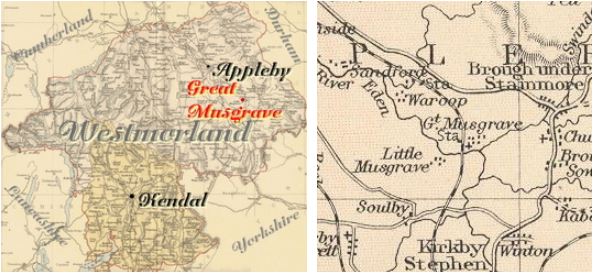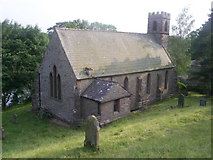Hide
Great Musgrave
hide
Hide
hide
Hide

Hide
Hide
"MUSGRAVE (GREAT), a parish in EAST ward, county of WESTMORLAND, 2 miles (W. S. W.) from Brough, containing 188 inhabitants. The living is a discharged rectory, in the archdeaconry and diocese of Carlisle, rated in the king's books at £16. 1. 11., endowed with £200 private benefaction, and £200 royal bounty, and in the patronage of the Bishop of Carlisle. The church is dedicated to St. Theobald. The parish is bounded on the south-east by the river Belo, and on the south-west by the Eden, which is crossed by a bridge of two arches, erected in 1826."
[From Samuel Lewis A Topographical Dictionary of England (1831) - copyright Mel Lockie 2016]
Hide
M.I.s for Musgrave were transcribed in Monumental Inscriptions of Westmorland by E. Bellasis 1888-89 and are available on Westmorland Papers.
| Great Musgrave, Wesleyan Methodist |
No returns survive for the 'census' of 1787 .
Census returns are available from the usual sources for 1841-1911.
Transcript and index for 1851 has been published by the Cumbria Family History Society and also in 'North Westmorland - An Index to the 1851 Census' compiled by David Lowis and Barbara Slack.
| Great Musgrave, Wesleyan Methodist |
 © William Metcalfe | St Theobald Simple church of 1845 by G R Appleby but contains a C13th coffin lid and brass of priest c1500. This and other photographs on the Geograph site Church plans from ICBS archive on Church Plans Online (Lambeth Palace Library). Photograph(s) and description on VisitCumbriaSt Theobald. |
Nicolson and Burn: The history and antiquities of the counties of Westmorland and Cumberland. 1777. Transcribed by Anne Nichols:
"Musgrave, without question, receives its name from the family which resided there for several ages, afterwards removed to Hartley castle, and finally settled and now continues at Eden-hall in Cumberland. Musgrave is a name of office. Grave means governor, steward, or keeper. So the sherrif is shire-grave: and there is a land-grave amongst the Germans; palsgrave (palace-grave); margrave or mark-grave, marquis, marchiarum comes, count or warden of the marches. And it is generally supposed, that Musegrave and Margrave are the same. But, as there is not much likeness between the words, so it is certain that this family did not receive their name from being wardens of the marches against Scotland; for the name is much ancienter than the introduction of that office into the borders. The learned Junius quotes Hesychius as explaining the word Muse to signify domesticum atrium, the curtilage about the house: And in that sense. it is easy to conceive the office of Musegrave. The parish of Musgrave is bounded by the parishes of Rumaldkirk and Brough on the East; by the parishes of Kirkby Stephen and Crosby Garret on the South; by the parish of Warcop on the West; and by the same parish of Warcop on the North: And contains in the whole about 38 families; all in the church of England [in 1777]. The church is dedicated to St. Theobald. In 1248 [was] granted to the bishop of Carlisle and his successors, the patronage of the church of Musgrave."
- Ask for a calculation of the distance from Great Musgrave to another place.
The Later Records relating to North Westmorland by John F. Curwen (1932) on British History Online.
Cumbria County History Trust has published a "Jubilee Digest" for the township of Musgrave.
Magna Britannica et Hibernia.Volume 6: Westmorland by Thomas Cox (Vicar of Bromfield, Essex) 45 pages, printed in 1731. Transcription by Sarah Reveley, Joan Fisher and Lisl Schoenwald. (Rootsweb Westmorland Listmembers) (c) 2003:
"Musgrave Great and Little, are two small Villages of no Note, but for giving a Name to the warlike Family of the Musgraves, which is Cambden's Opinion; but our more modern Antiquaries think, and as they add, with greater Probability, that the towns had their Names from the Family. For the Name of Musgrave is to be reckoned among those that are taken from Offices, and civil or military Honours, and is of the like Original as Landt-graff, Markgraff, and Burghgraffe; and 'tis probable that this Name, and Markgraffe, (now turned into our English Marquis) are much the same. Their Signification is Dux Limitaneus, which we call a Lord Warden of the Marches: 'Tis probable that this Family of Musgraves had a Seat here, because Thomas Lord Musgrave, 32 Edw. III. obtained a Charter of Free Warren in all his Demesne Lands here, with a Power to impark his Woods called Hevenings in these Towns, containing Two hundred Acres.What more is remarkable of this Family, ee above in Herkla-Castle, and Heartley Castle. The family of Musgraves, though none of them noble after the Death of the said Thomas, yet have continued almost ever since Men of Note; but these Lordships after his Death must have been some Way alienated from his Posterity, because we find Roger Lord Clifford 4th died possessed of these Manors 13 Rich. II. and left them to his Son and Heir Thomas, etc."
You can see maps centred on OS grid reference NY779174 (Lat/Lon: 54.551652, -2.342717), Great Musgrave which are provided by:
- OpenStreetMap
- Google Maps
- StreetMap (Current Ordnance Survey maps)
- Bing (was Multimap)
- Old Maps Online
- National Library of Scotland (Old Ordnance Survey maps)
- Vision of Britain (Click "Historical units & statistics" for administrative areas.)
- English Jurisdictions in 1851 (Unfortunately the LDS have removed the facility to enable us to specify a starting location, you will need to search yourself on their map.)
- Magic (Geographic information) (Click + on map if it doesn't show)
- GeoHack (Links to on-line maps and location specific services.)
- All places within the same township/parish shown on an Openstreetmap map.
- Nearby townships/parishes shown on an Openstreetmap map.
- Nearby places shown on an Openstreetmap map.
Window Tax records for 1777 Musgrave Great transcribed on Edenlinks.
Hearth Tax records for 1674 Great Musgrave transcribed on Edenlinks.
